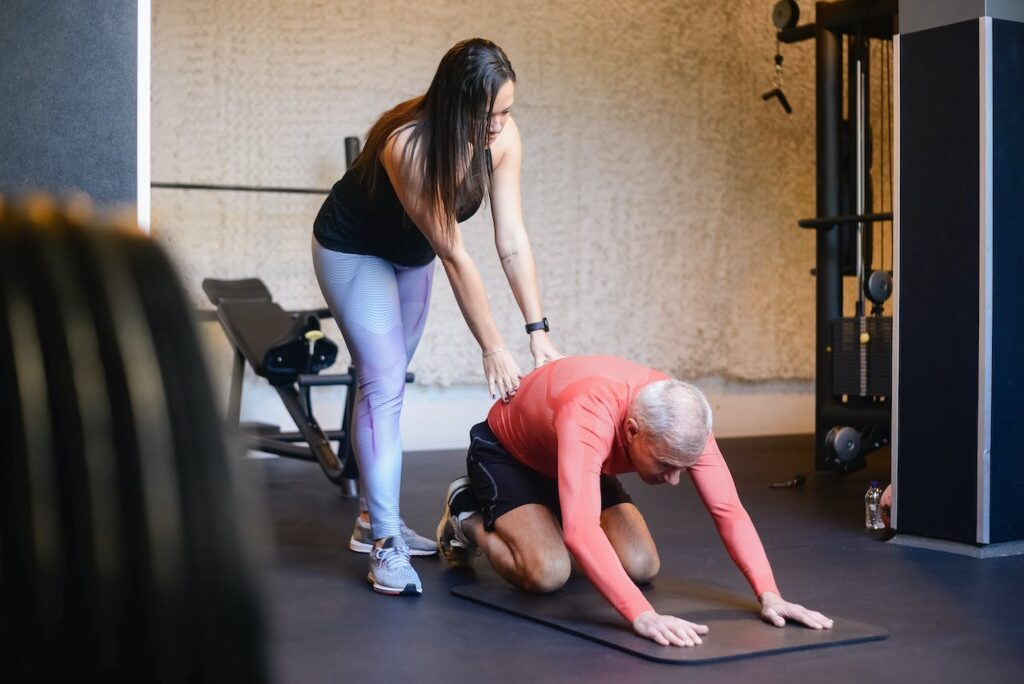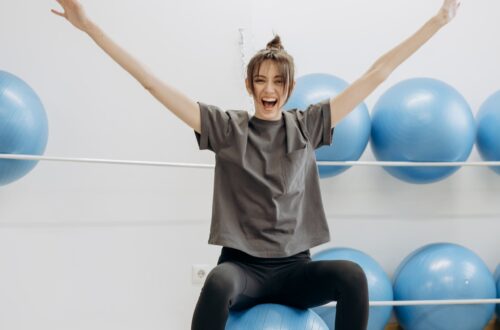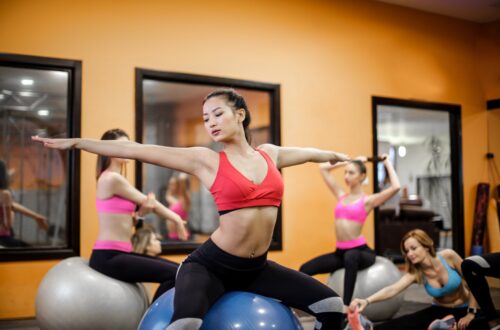
Weight Lifting for Seniors: Stay Strong and Active as You Age
Aging is a natural process that brings about various changes in our bodies, including a decline in muscle mass, bone density, and overall strength. As individuals age, maintaining an active lifestyle becomes increasingly important for overall health and well-being. Seniors, in particular, can greatly benefit from incorporating regular physical activity into their daily routines.
One form of exercise that holds significant advantages, especially for older adults, is weight lifting or resistance training. This form of exercise helps promote strength, flexibility, balance, and overall functionality, contributing to a higher quality of life in the aging population. In this blog, we will explore how weightlifting can be a key ingredient in the recipe for a fulfilling and healthy lifestyle for seniors.
Importance of Staying Active for Seniors
Staying active is crucial for seniors to maintain optimal health and well-being as they age. Regular physical activity not only enhances cardiovascular health but also plays a crucial role in maintaining joint flexibility and muscle strength, key factors in preventing falls and injuries commonly associated with aging.
Engaging in consistent exercise has been linked to improved cognitive function, promoting mental acuity and reducing the risk of cognitive decline. Additionally, staying active fosters a sense of independence and boosts mood by releasing endorphins, combating feelings of loneliness and depression. Whether through brisk walks, gentle aerobics, or other low-impact activities, seniors can tailor their exercise routines to match their fitness levels, ensuring a more vibrant and fulfilling lifestyle well into their golden years.
Why Weight Lifting is the New Cool for Seniors
As the world evolves and perceptions of aging shift, seniors are embracing a new definition of cool – one that involves pumping iron and reveling in the joy of an active and fabulous lifestyle. Keeping active and fabulous for seniors has become the latest trend in weight lifting. Here’s what’s driving its popularity.
- Defying Stereotypes: Forget the stereotypes of rocking chairs and slow-paced activities. Seniors are rewriting the script by embracing weight lifting, challenging preconceived notions of what it means to age. Pumping iron is not just for the young; it’s for those who dare to defy expectations and redefine cool.
- Ageless Strength and Confidence: Weight lifting isn’t just about building muscles; it’s about cultivating strength and confidence that knows no age limits. Seniors are discovering the empowering feeling of lifting weights, proving that strength is timeless and can be cultivated at any stage of life.
- Radiant Wellness: The joy of staying active and fabulous radiates from within. Weight lifting isn’t just a physical exercise; it’s a holistic approach to wellness. Seniors engaging in regular weight lifting experience a glow of vitality that shines through, contributing to an overall sense of fabulousness.
- Social Connection: The weight lifting community is diverse and inclusive, bringing seniors together in a shared pursuit of health and strength. Socializing while pumping iron not only adds a fun element but also creates a supportive network of like-minded individuals, making the journey towards an active lifestyle even more enjoyable.
- Fashionable Fitness: Seniors are not just hitting the gym; they’re doing it in style. The latest fitness gear and accessories have become a part of the cool senior’s ensemble. The gym is not just a workout space; it’s a runway for showcasing a fabulous and active lifestyle.
- Youthful Energy: Weight lifting is a natural energy booster. Seniors are discovering that staying active doesn’t drain energy; it revitalizes it. The joy of having a youthful energy and vitality contributes to an overall sense of fabulousness that is contagious.
- Celebrating Personal Victories: Every lift, every set, and every milestone reached in weight lifting becomes a personal victory to celebrate. Seniors are relishing the joy of surpassing their own expectations, proving that the journey of staying active and fabulous is as rewarding as the destination.
weight lifting is not just about the physical benefits; it’s about embracing a lifestyle that exudes joy, confidence, and an unwavering commitment to staying active and fabulous.
Pump Up the Benefits
Weight lifting, or resistance training, offers numerous benefits for seniors, promoting overall health and well-being. Here are some specific advantages:
Muscle Strength for Everyday Activities:
- Improved Functional Abilities: As people age, they may experience a natural decline in muscle mass and strength. Weight lifting helps counteract this by targeting and strengthening various muscle groups. This increased strength translates into improved abilities to perform everyday tasks like lifting objects, walking, or getting up from a seated position.
Bone Density and Longevity:
- Bone Health: Weight lifting imposes stress on the bones, prompting the body to adapt by increasing bone density. This is crucial for seniors, as bone density tends to decrease with age, leading to conditions like osteoporosis. By maintaining or increasing bone density, weight lifting contributes to overall bone health and longevity.
Metabolism Boost and Weight Management:
- Increased Metabolic Rate: Metabolism refers to the body’s ability to burn calories for energy. Weight lifting helps increase the metabolic rate, meaning the body continues to burn calories even when at rest. This can be beneficial for weight management, as a higher metabolism makes it easier to maintain a healthy weight.
Enhanced Joint Flexibility for Agility:
- Improved Joint Functionality: Weight lifting involves a range of movements that engage joints. Over time, this can lead to increased joint flexibility and reduced stiffness. Improved joint flexibility is essential for maintaining agility and preventing injuries associated with decreased flexibility.
Balance and Fall Prevention:
- Enhanced Stability: Weight lifting exercises often involve balance and coordination. As seniors work on these aspects during their workouts, they enhance their overall stability, reducing the risk of falls. Falls can be a significant concern for older individuals, and improving balance is a key preventive measure.
Cognitive Benefits:
- Brain Health: Regular exercise, including weight lifting, has been linked to cognitive benefits. It may help preserve cognitive function and reduce the risk of conditions like dementia. The mental focus required during weight lifting sessions can also contribute to overall cognitive well-being.
Mood and Stress Reduction:
- Release of Endorphins: Exercise, including weight lifting, triggers the release of endorphins, which are chemicals in the brain associated with feelings of pleasure and reduced stress. This mood-enhancing effect can contribute to overall mental well-being.
Chronic Disease Management:
- Improved Management of Chronic Conditions: Weight lifting has been shown to have positive effects on various chronic conditions, such as diabetes, arthritis, and heart disease. It can contribute to better management of these conditions and may even reduce the need for medication in some cases.
Disease Prevention:
- Guarding Against Age-Related Decline: The transformative power of weight lifting extends beyond muscles to safeguard against age-related decline. As we age, bone density, muscle mass, and metabolism naturally decrease. Weight lifting serves as a formidable guardian, countering these effects and slowing the hands of time.
Note: Before starting any exercise program, especially for seniors, it’s important to consult with a healthcare professional or a fitness expert to ensure that the chosen activities are appropriate for individual health conditions and fitness levels.
Starting Your Weight Lifting Journey
Getting started with weight lifting for elders involves taking several precautions to ensure a safe and effective exercise routine. Here are some important steps to consider:
Consulting with the Doc – The First Lift of the Journey:
- Medical Consultation: The journey begins with a conversation with a healthcare professional. This is essential for obtaining medical clearance and ensuring that weight lifting is safe given the individual’s health status, any existing medical conditions, or medications. The doctor can provide valuable insights into specific considerations and potential modifications for the exercise plan.
- Establishing Baseline Health: The consultation helps establish a baseline health profile, identifying any potential risks or concerns that may impact the exercise program. It sets the foundation for a customized approach to weight lifting that aligns with the individual’s health needs and goals.
Customizing Workouts: Because One Size Doesn’t Fit All:
- Personalized Exercise Plan: Recognizing that everyone is unique, the next step is to customize the workout plan. This involves tailoring exercises to the individual’s fitness level, preferences, and any specific health considerations. A customized approach ensures that the workout is challenging yet achievable, fostering adherence and success.
- Incorporating Preferences: Understanding the individual’s preferences is crucial for long-term commitment. Whether it’s a preference for certain types of exercises, working out at a specific time of day, or incorporating favorite activities, customization makes the fitness journey more enjoyable.
- Progressive Adaptation: The exercise plan should be designed with a progressive approach, gradually increasing intensity and resistance as the individual gains strength and confidence. This helps prevent overexertion and reduces the risk of injury.
Lifting Form – Because Nobody Wants to Pull a Muscle on the Runway:
- Educating on Proper Form: Emphasizing the importance of proper lifting form is key to preventing injuries. Guidance on correct posture, movement patterns, and breathing techniques should be provided. This might involve hands-on instruction, video demonstrations, or written materials to reinforce the principles of good form.
- Start Slow, Focus on Control: The initial lifts should prioritize control over heavy weights. This not only helps in mastering proper form but also minimizes the risk of strains or muscle pulls. A slow and controlled approach promotes muscle engagement and reduces the likelihood of overexertion.
- Regular Check-Ins: Periodic check-ins with a fitness professional or trainer can provide ongoing support and ensure that proper form is maintained. This is especially important as the individual progresses and takes on more challenging exercises.
- Injury Prevention Tips: Alongside proper form, educating seniors on injury prevention strategies, such as proper warm-ups, cool-downs, and the importance of rest days, contributes to a sustainable and injury-free fitness journey.
This “Senior Lift-Off” approach emphasizes the significance of medical consultation, customization of workouts, and a focus on lifting form.
A Sample Senior-Friendly Routine
Before starting any new exercise program, seniors need to consult with their healthcare professionals to ensure the program is safe for their health conditions. Here’s a sample senior-friendly weight-lifting routine that includes warm-up exercises, beginner-friendly weight-lifting exercises, and progression tips for gradual improvement.
Warm-up Exercises:
A proper warm-up helps prepare the body for exercise by increasing blood flow to the muscles and improving joint flexibility.
Cardiovascular Warm-Up:
- 5 minutes of brisk walking or marching in place to increase heart rate and warm up the body.
Joint Mobility:
- Arm circles (30 seconds each direction).
- Leg swings (15 swings for each leg).
- Neck tilts and rotations (10 reps each).
Dynamic Stretches:
- Shoulder rolls (10 reps forward and backward).
- Side-to-side torso twists (15 reps).
- Ankle circles (10 circles in each direction for each ankle).
Beginner-Friendly Weight Lifting Exercises:
Bodyweight Squats:
- Stand with feet shoulder-width apart.
- Slowly lower your body by bending at the hips and knees.
- Keep the back straight and chest up.
- Perform 2 sets of 10-12 repetitions.
Seated Leg Press (Using Resistance Bands or Light Weights):
- Sit on a sturdy chair with resistance bands under your feet.
- Push your legs forward, extending at the knees.
- Perform 2 sets of 10-12 repetitions.
Bicep Curls (Using Light Dumbbells or Resistance Bands):
- Stand with feet shoulder-width apart, holding a weight in each hand.
- Curl the weights towards your shoulders, keeping elbows close to your body.
- Perform 2 sets of 10-12 repetitions.
Standing Calf Raises:
- Stand near a support surface (like a chair) for balance.
- Rise onto your toes, lifting your heels off the ground.
- Perform 2 sets of 15-20 repetitions.
Wall Push-Ups:
- Stand facing a wall, arms extended at chest height.
- Lean forward and perform push-ups against the wall.
- Perform 2 sets of 10-12 repetitions.
Progression Tips for Gradual Improvement:
Gradually Increase Resistance:
- As strength improves, gradually increase the resistance. This can be achieved by using slightly heavier weights or increasing the tension in resistance bands.
Add Variations and Complexity:
- Introduce variations of the exercises to target different muscle groups.
- For example, progress from bodyweight squats to goblet squats using a light dumbbell.
Increase Sets and Repetitions:
- Once comfortable with the initial sets and reps, gradually increase the intensity by adding an extra set or increasing the number of repetitions.
Include Balance Exercises:
- Incorporate balance exercises, such as single-leg stands or heel-to-toe walking, to enhance stability and coordination.
Monitor Rest Periods:
- Gradually reduce rest periods between sets as fitness levels improve. This helps increase the overall intensity of the workout.
Stay Consistent:
- Consistency is key. Aim for at least two to three sessions per week, allowing for recovery days between workouts.
Note: If there are any concerns or if new exercises are introduced, it’s advisable to consult with a fitness professional for guidance. Adjustments to the routine can be made based on individual progress and preferences.
Balancing Nutrition and Recovery
Balancing nutrition and ensuring proper recovery are crucial components of senior fitness. As individuals age, their nutritional needs may change, and the importance of recovery becomes even more significant. Here’s a breakdown of the role of a balanced diet in senior fitness and the importance of proper recovery and rest:
Balanced Diet in Senior Fitness:
Nutrient Requirements:
- Seniors need a well-rounded diet that includes a balance of macronutrients (carbohydrates, proteins, and fats) and micronutrients (vitamins and minerals).
- Adequate protein intake is essential for maintaining muscle mass, bone density, and overall strength. This becomes particularly important as aging often leads to muscle loss.
- Calcium and vitamin D are crucial for bone health, helping to prevent osteoporosis and fractures.
Hydration:
- Staying hydrated is important for seniors as dehydration can affect cognitive function, joint health, and overall well-being.
- Older adults may have a decreased sense of thirst, so it’s essential to encourage regular fluid intake.
Fiber and Digestive Health:
- Adequate fiber intake supports digestive health and can help prevent constipation, a common issue among seniors.
- Whole grains, fruits, and vegetables are good sources of fiber.
Heart Health:
- A heart-healthy diet is essential for seniors to prevent cardiovascular issues. This includes limiting saturated and trans fats while incorporating sources of omega-3 fatty acids.
Micronutrients:
- Seniors may need to pay attention to specific micronutrients like vitamin B12, which is important for nerve function, and vitamin B6, which supports immune function.
Importance of Proper Recovery and Rest:
Muscle Recovery:
- Adequate rest is crucial for the recovery of muscles, especially after physical activity or exercise.
- Seniors may need more time for recovery due to potential age-related changes in muscle mass and joint health.
Sleep Quality:
- Quality sleep is essential for overall health and well-being.
- Seniors may face challenges with sleep, so establishing good sleep hygiene practices is important.
Joint Health:
- Aging can bring about joint issues, and proper rest helps in reducing stress on joints.
- Activities like stretching and low-impact exercises can aid in joint flexibility and mobility.
Mental Health:
- Rest is vital for mental health, helping to reduce stress, anxiety, and improve cognitive function.
- Activities like meditation or relaxation exercises can contribute to mental well-being.
Injury Prevention:
- Adequate rest helps prevent overuse injuries, especially important for seniors to avoid strains and sprains.
Note: It’s advisable for seniors to consult with healthcare professionals or nutritionists to create personalized plans that address their individual requirements and goals. Regular exercise, adequate nutrition, and sufficient rest collectively contribute to a holistic approach to senior fitness and well-being.
Overcoming Common Concerns
Addressing Fears and Misconceptions:
- Fear of Injury: Many seniors may fear getting injured during exercise. It’s important to emphasize that with proper guidance, a well-designed exercise program can be safe and beneficial. Starting with low-impact activities and gradually progressing helps mitigate this concern.
- Misconceptions about Aging: Some seniors believe that they are too old to start or continue exercising. It’s crucial to convey that exercise can be adapted to individual abilities and can improve health and quality of life at any age.
- Concerns about Pain: Fear of pain, especially for those with chronic conditions like arthritis, may hinder participation in physical activities. Educating individuals about the difference between manageable discomfort and harmful pain is essential. A tailored exercise program that considers existing health conditions can help manage pain.
- Lack of Time: Seniors may feel that they don’t have enough time to exercise. Breaking down physical activity into shorter, more manageable sessions throughout the day can be just as effective. This can include activities like walking, stretching, or chair exercises.
Tips for Managing Arthritis and Joint Issues:
- Low-Impact Exercises: Opt for low-impact activities like walking, swimming, or cycling, which are easier on the joints. These activities can help maintain mobility without putting excessive strain on arthritic joints.
- Strength Training: Strengthening the muscles around joints provides additional support and can alleviate some of the stress on the joints. Focus on light resistance exercises with proper form and technique.
- Range of Motion Exercises: Engage in activities that promote joint flexibility and range of motion. Gentle stretches and movements can help improve flexibility and reduce stiffness associated with arthritis.
- Warm-Up and Cool Down: Prioritize warming up before exercise and cooling down afterward. This is particularly important for individuals with arthritis as it helps prepare the joints and muscles for activity and reduces the risk of stiffness.
- Listen to Your Body: Pay attention to how your body responds to different activities. If an exercise causes pain beyond normal discomfort, it may be necessary to modify or avoid it. Consulting with a healthcare professional or a physical therapist can provide personalized guidance.
Importance of Gradual Progression:
- Avoiding Overexertion: Gradual progression is crucial, especially for seniors, to avoid overexertion and reduce the risk of injury. Starting with activities of lower intensity and gradually increasing the duration and intensity allows the body to adapt.
- Building Stamina: Progressing gradually helps build stamina and endurance over time. This is essential for seniors who may experience fatigue more quickly than younger individuals.
- Adaptation to Exercise: The body needs time to adapt to new physical activities. Slow and steady progress allows for the adaptation of muscles, joints, and cardiovascular systems, reducing the likelihood of strain or injury.
- Sustainability: Gradual progression makes exercise more sustainable in the long term. It helps establish a routine that can be maintained, promoting consistent physical activity for overall health benefits.
- Consulting Professionals: Before starting a new exercise regimen, seniors should consult with healthcare professionals or fitness experts. They can provide personalized guidance based on individual health conditions and help design a safe and effective exercise plan.
Note: In conclusion, staying active, especially through activities like weight lifting, is crucial for seniors to enjoy a fuller and healthier life. The benefits extend beyond physical health, encompassing mental well-being and social connection, making it an integral component of aging gracefully.
Conclusion
So, to all the seniors out there, it’s time to redefine what aging looks like. Weightlifting isn’t reserved for the young; it’s a tool for everyone keen on embracing the years ahead with strength and vitality. As the saying goes, “You don’t stop lifting when you get old; you get old when you stop lifting.” Let this be your call to action – pick up those weights, start slow, and witness the transformation in your strength, mood, and overall well-being. Age is just a number, but your strength is timeless. Stay strong, stay active, and embrace the journey of aging with the power of weight lifting by your side and let the journey toward a stronger, more vibrant you begin today! Your best years are yet to come!


You May Also Like

Pilates vs Yoga: Which will give you a better workout?
8 March 2024
7 Ways Pilates Can Keep You Injury-Free During Exercise
19 December 2023